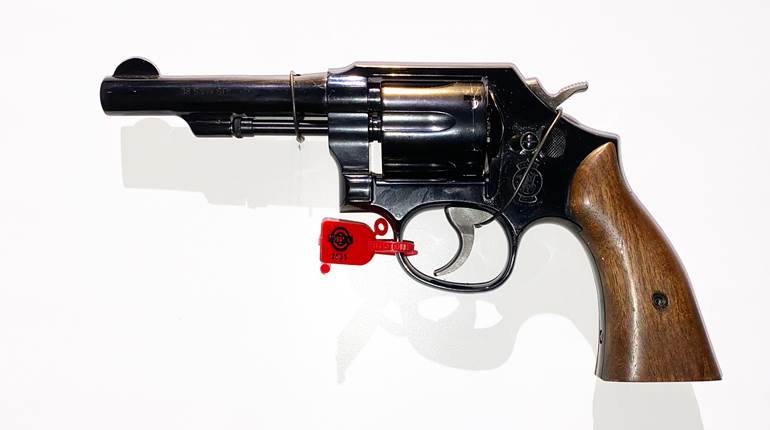
Color images courtesy Rock Island Auction
In 1939, with war in Europe looking likely, the British government began to prepare for the worst, starting with acknowledging its need to re-arm. The British manufacturing industry swung into action, upping production of the British Army’s standard-issue Lee-Enfield rifle. The government established the British Purchasing Commission, headed by industrialist Arthur Purvis, to ask American arms manufacturers to procure enough weapons to arm Britain’s military as it rapidly expanded to a wartime footing.
The Purchasing Commission used Britain's gold reserves to purchase directly from manufacturers, with orders placed for everything from revolvers and rifles to submachine guns like the Thompson. In March 1941, the Commission's role was replaced by the Lend-Lease Act, which saw billions of dollars worth of equipment, aircraft, vehicles and weapons transferred by 1945.
One of the manufacturers approached by the Purchasing Commission was Smith & Wesson, who was contracted to produce its Military & Police (later the Victory Model) revolvers chambered in Britain’s .38/200 cartridge. Additionally, the British government asked Smith & Wesson to develop a new 9x19mm carbine. The result would become the Model 1940 Light Rifle.
The Light Rifle was designed by Smith & Wesson's chief designer, Edward S. Pomeroy, following a request from the British in mid-1939. The resulting pistol-caliber carbine proved to be a thoughtfully and beautifully, if hastily designed, manufacturer failure.

In June 1939, the specifications, drawings and several prototype models of Pomeroy’s light rifle were dispatched to Britain for approval. It was given a cursory appraisal and accepted. Following approval, the first production carbines arrived in Britain for testing in early 1940. The Model 1940 Light Rifle’s manual described the carbine as filling “… the need for a light, fast, easy handling, multiple fire weapon. It is rugged, dependable and easy to operate.” At first glance ithe Model 1940 might be mistaken for a submachine gun, especially considering its caliber and the fact it fires from an open bolt. However, it does not fire fully automatically, in theory making it a carbine rather than a “machine carbine” as the British designated their submachine guns. 
The Model 1940 used a blowback action, typically used in submachine guns, and was chambered in 9x19 mm. It fed from a 20-round double-stack detachable magazine. The magazine was held in place by a large catch at the base of the magazine housing. This housing is one of the Model 1940′s more unusual features, as it descends down from the receiver the full length of the magazine with the rear half containing what the weapon's manual describes as an “ejector tube.” Spent cartridge cases would be ejected from the action and travel down this tube, out of the weapon. One of the gun’s seemingly positive attributes was that its action is sealed, however, meaning the action and breech could not be inspected without fieldstripping the weapon. If a case failed to eject it could only be cleared by a cleaning rod or by field stripping the gun—a severe drawback in the field.

The Model 1940 was carefully made and finely blued but proved to be an extremely time-consuming and expensive gun to produce. Rather than being made from stamped sheet metal as other guns like the STEN, the Model 1940′s receiver, frame, magazine housing and internal parts were all milled from drop-hammer-forged manganese steel. Perhaps in an attempt to lighten the weapon, the Model 1940s had a Tenonite (an early plastic) buttstock. Similarly, the carbine’s 9.75” (24.7 cm) tapered barrel had 12 longitudinal flutes cut into it in a vain effort to remove weight. The machining needed to make these lightening cuts, however, was time consuming and costly. Despite these features, the Model 1940 weighed a hefty 8 lbs. 10 ozs. (3.92 kg) unloaded. When compared to the later STEN MkII’s 7 lbs., the Model 1940 was seen as unacceptably heavy. In 1942, the Royal Small Arms Factory at Enfield made an unsuccessful attempt to lighten and improve the gun’s handiness with a lighter buttstock for possible issue to the Royal Navy. The carbine’s sights were also unnecessarily complicated with a micrometer click-adjustable U-notch rear sight, adjustable for range between 50 and 400 yards (which required 22 clicks).
The British had given Smith & Wesson an advance of roughly $1 million, approximately $17,705,000 today, for the speedy development and production of the first batch of Model 1940s. The first Light Rifles began to arrive in Britain in 1940 in crates of 10. They were shipped with two 20-round magazines and a manual for each carbine along with one spanner per crate, for removing the barrel. When they were received and evaluated, a number of flaws and issues were soon discovered. It was found that the Model 1940 was unable to pass a 5,000-round endurance test because the weapon could not handle high-pressure British service ammunition.

The Model 1940 was chambered and proofed in 9x19mm, however, the American 9 mm ammunition with which it was tested and proofed was substantially less powerful than the British army’s standard 9 mm round designed for submachine guns. The stouter British round threw the Model 1940′s bolt back, violently hitting the rear of the receiver. After approximately 1,000 rounds it was found that the rear of the receiver tube which was screwed on would snap and break under pressure and repeated battering by the weapon’s bolt. By comparison, the Lanchester submachine gun, Britain's high-quality copy of the German MP28/II, was specifically manufactured to fire any 9 mm ammunition it was fed.
This led to the development of a MkII version of the Model 1940. Smith & Wesson reworked the design, placing a solid sleeve over the weaker middle part of the carbine’s receiver. This ridged sleeve was also adapted to act as a bolt lock replacing the cumbersome lever safety on the right side of the receiver. Another change was the move from an integral floating firing pin and hammer to a firing pin fixed to the bolt in the MkII.

Despite these changes, once approximately 1,000 carbines had been received, the British cancelled the project and refused to receive any more, requesting the refund of their $1 million advance. Smith & Wesson, however, could not afford to pay the advance back as they had invested a significant amount in tooling up for production of the Model 1940. Instead they offered a deal that saw the revolvers Smith & Wesson were producing for Britain be sold at a reduced price. This revolver was designated the Smith & Wesson No.2 by the British and was chambered in the British .38/200 round. Over a million of these revolvers were made by 1944. It is unclear if the Model 1940 was ever operationally issued. Given its problems it seems unlikely, although some sources suggest it may have been issued as a stopgap to the RAF for defending airfields.

The Model 1940 was also evaluated by the U.S. Army Ordnance Department as a preliminary to the U.S. Army's Light Rifle Trials, however, being chambered in 9 mm rather than .45 ACP or the .30 Carbine round and only firing in semi-automatic they were quickly rejected and Smith & Wesson was advised to rechamber it and adapt it to fully automatic fire. The U.S.' Light Rifle Trials eventually selected a carbine developed by Winchester, which was adopted as the M1 Carbine.
The Model 1940 is a quirk of firearms history, a semi-automatic-only carbine chambered in a pistol round, which was extremely heavy for its intended purpose, weighing approximately 9 lbs. (4.08 kg) when loaded. Its ergonomics were cumbersome and its manual of arms flawed. While its design was defective, the carbine was extremely well-manufactured from high-quality materials. Smith & Wesson manufactured 2,200 frames but only completed 1,227 with 1,010 being shipped to Britain, the vast majority being the flawed MkIs and approximately 200 MkII’s, before the order was cancelled. At the end of the war, remaining British stocks of the Model 1940 were disposed of in the English Channel, along with hundreds of thousands of tons of other war surplus. Those that remain were retained for references purposes and a small batch of unshipped rifles found at Smith & Wesson’s factory in the 1970s, today in the United States these carbines can sell for between $5,000 and $12,000.
Specifications:
Action: Blowback
Caliber: 9x19 mm
Feed: 20-round magazine
Rate of Fire: 70 rounds per minute
Weight (Unloaded): 8 lbs. 4 ozs. (3.74 kg)
Length: 32" (81 cm)







































